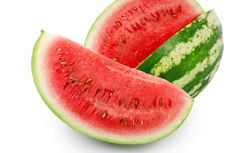 |
| Some of the different pulp varieties. Source: NCSU |
 |
| Diversity in watermelon fruit shape and color. Source: NCSU |
The following article, published in Slate, explains why the watermelon variety most commonly eaten in the U.S. has white and black seeds.
What's With White Watermelon Seeds?
(Read after the break)
What's With White Watermelon Seeds?
They're just immature.
Posted Friday, July 29, 2011, at 12:03 PM ET
 Watermelons, as anyone who's ever eaten one has likely noticed, contain both small white seeds and larger black ones. Seeing as it's watermelon season, the Explainer thought she'd answer the terribly pressing question: What's the difference between the seeds?
Watermelons, as anyone who's ever eaten one has likely noticed, contain both small white seeds and larger black ones. Seeing as it's watermelon season, the Explainer thought she'd answer the terribly pressing question: What's the difference between the seeds?Maturity. All watermelon seeds start off small and white before growing into larger black, red, tan, or dotted seeds. (More on these less-familiar colors later.) The average American watermelon has about 200 to 800 seeds, and roughly 5 percent of those are still immature upon harvest. These seeds are infertile, so unlike their black cousins, you can't use them to plant your own crop of watermelons.
Undeveloped seeds should not be confused with seeds from white-seeded watermelons, which are very common in China and the Middle East (not so much here). American farmers tend to produce watermelons of the black-seeded variety for aesthetic reasons, but watermelons have a vast array of gene combinations that can produce a variety of seed, rind, and flesh colors.
Along with squash, cucumber, cantaloupe, and pumpkin, watermelons are members of the cucurbit family, which produce fruits called "pepo"—modified berries with thick rinds and a fleshy center. While all cucurbits start out with white seeds, watermelons are the only ones with seeds that can then change into various colors.
Despite the childhood myth that swallowing watermelon seeds will cause you to grow a watermelon inside your stomach, all watermelon seeds—mature and immature—are perfectly edible. Some speculate that if you swallow a whole seed it could get stuck in your intestines, but chewing it up a bit will solve that problem. Watermelon seeds are filled with vital nutrients that can give you a large dose of your day's recommended protein intake.
Bonus Explainer: Why do "seedless watermelons" have seeds? They only look like they do. Seedless watermelons are sterile hybrids, but they sometimes contain little hard seed coats. If you look inside of these, you'll find that they're completely empty.
No comments:
Post a Comment